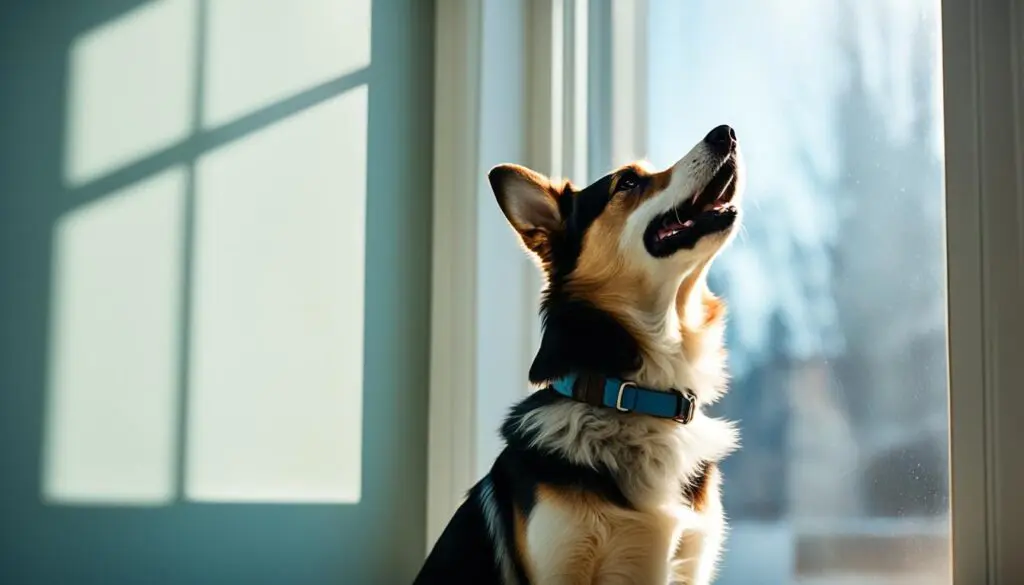How to Stop Dogs from Barking: Effective Tips
I’ve always loved dogs and know how hard it can be to deal with their barking. Whether it’s a chatty puppy or an adult dog that won’t stop, the noise can be tough. But don’t worry, I’ve got some expert advice to help you stop your dog from barking. This will make your home more peaceful for everyone.

Key Takeaways
- Understand the underlying reasons for your dog’s barking, such as boredom, territorial behavior, or separation anxiety.
- Implement positive reinforcement training methods to teach your dog when it’s appropriate to bark and when to be quiet.
- Create a calm and stimulating environment to prevent boredom and reduce the triggers that may lead to excessive barking.
- Gradually desensitize your dog to separation anxiety and provide comfort and distractions when you’re away.
- Consistency and patience are key when training your dog not to bark excessively.
Next, I’ll share more about these strategies and give you the tools to stop your dog’s barking. Get ready for a quieter, happier home. Your dog and your neighbors will appreciate it!
Understanding the Reasons Behind Excessive Barking
Dealing with a barking puppy starts with knowing why they bark so much. As a pet owner, figuring out what makes your dog bark is key to solving the problem. Let’s look at the main reasons why dogs bark too much.
Boredom and Lack of Stimulation
Dogs are smart and need to stay active both in body and mind. Without enough to do, they might bark a lot to get rid of boredom and extra energy. This is especially true for energetic breeds or dogs that don’t get enough exercise and fun time.
Territorial Behavior and Protective Instincts
Many dogs guard their territory, whether it’s their home, yard, or family. If they see a stranger or another animal, they might bark a lot to warn and protect their space. This comes from their natural instinct to keep their pack and things safe.
Knowing why your dog barks is the first step to fixing it. By understanding what causes their barking, you can work on how do you train a dog not to bark. This helps make a peaceful home for you and your dog.
Stop Dogs from Barking: Training Techniques
Teaching your dog not to bark is crucial. Positive reinforcement and reward-based training work well. This method rewards good behaviors instead of punishing bad ones.
Positive Reinforcement and Reward-Based Training
Positive reinforcement means rewarding your dog when they’re not barking. Use treats, praise, or playtime to do this. This encourages calmness and quietness.
By rewarding your dog for being well-behaved, you can change their barking habits. You teach them better ways to communicate.
Bark Control Devices and Their Effectiveness
Some pet owners use bark control devices to stop excessive barking. These include ultrasonic or vibration-based collars. They provide a harmless signal to stop barking.
But, use these devices carefully. They should be part of a training plan that includes positive reinforcement. They don’t solve all barking issues.
Combining training with a calm environment works best. With patience and consistency, your dog can learn to bark less. They’ll find better ways to communicate.
Creating a Calm Environment for Your Furry Friend
Creating a calm and comfy space can really help your dog stop barking when you’re away. By making a peaceful place and meeting your dog’s needs, they’ll feel safe and happy. This can cut down on the barking when you’re not there.
It’s important to make sure your dog gets enough exercise. A dog that’s active won’t get bored and bark too much. Try daily walks, playtime, and toys that challenge their mind and body.
Also, set a regular daily routine for your dog. Having a predictable schedule can ease their anxiety and make them feel secure. Include times for rest, meals, and play to make their life balanced and calm.
These simple steps can make a big difference in your dog’s behavior. A happy and calm dog won’t bark as much, especially when you’re away. Remember, a well-cared-for dog is less likely to bark too much.
Addressing Separation Anxiety and Loneliness
Separation anxiety and loneliness are big reasons why dogs bark a lot. When dogs are left alone for a long time, they can get anxious. This anxiety often makes them bark a lot. We need to help our dogs get used to being alone slowly.
Gradually Desensitizing Your Dog
To help your dog stop barking when you leave, start by leaving them alone for short times. Then, slowly make these times longer. This teaches them that being alone isn’t scary. Also, give them toys or puzzle feeders to keep them busy while you’re out.
Providing Comfort and Distractions
- Create a cozy spot for your dog to go to when you’re away, like a crate or a special area with their favorite things.
- Use calming pheromones, such as Dog Appeasing Pheromone (DAP), to calm your dog down.
- Leave the TV or radio on to make some noise and make them feel like you’re still there.
By slowly getting your dog used to being alone and giving them things to distract them, you can stop their dog barking when left alone. This makes them feel safer and happier when you’re not there.
How do you train a dog not to bark?
Training a dog to stop barking can be tough, but it’s doable with patience and consistency. First, figure out why your dog is barking. Then, use training methods to help them stop.
Consistency and Patience: Keys to Success
Being consistent is key when teaching a dog not to bark. You need a clear routine with the same commands and rewards. Patience is also key, as changing a habit like barking takes time and effort.
Here are some tips to help you train your dog not to bark:
- Identify the triggers: Watch for when and why your dog barks. This helps you know how to train them better.
- Use positive reinforcement: Give your dog treats, praise, or their favorite toy when they’re quiet. This encourages the good behavior.
- Teach the “quiet” command: Say “quiet” when your dog barks and give them a reward when they stop. They’ll learn to connect the word with being quiet.
- Provide mental and physical stimulation: A bored dog may bark more. Make sure they get enough exercise and fun activities every day.
Training a dog not to bark takes time and consistency. Keep at it, and you’ll see your dog’s barking decrease over time.
Puppy Barking: Nipping the Habit in the Bud
As a new puppy owner, it’s key to tackle puppy barking early. This habit can become hard to manage if not stopped. With the right steps, you can help your puppy be quieter and calmer.
To stop puppy barking, mix early socialization, positive reinforcement, and a steady routine. Here are some ways to get a puppy to stop barking:
- Early Socialization: Show your puppy different sights, sounds, and experiences in a safe way. This makes them more confident and less likely to bark from fear or stress.
- Positive Reinforcement: Give your puppy treats and praise when they stay calm and quiet. This makes them want to act this way again.
- Consistent Routine: Puppies like knowing what to expect. Make a regular schedule for eating, playing, and sleeping. This helps your puppy feel safe and less likely to bark.
Remember, changing puppy barking habits takes time and patience. With effort, you can get a puppy to stop barking and have a quieter home.
Teach Your Dog Not to Bark at Specific Triggers
We’ve all felt the annoyance of our dogs barking nonstop at certain things. It could be a stranger walking by, a delivery truck driving by, or another animal in the yard. These things can make our dogs bark a lot. But, with patience and the right training, we can teach our dogs not to bark at these things.
Identifying and Managing Triggers
First, we need to figure out what makes our dogs bark. Pay attention to what situations, sounds, or sights make your dog bark. Knowing what triggers the barking is key. Then, we can start managing it with training and changes in the environment.
- Desensitize your dog: Slowly introduce your dog to the trigger in a controlled setting. Give treats and praise for staying calm. This helps your dog see the trigger as something good, not a reason to bark.
- Provide alternative behaviors: Teach your dog a new behavior, like sitting or lying down, when they see the trigger. Always give them a treat for this new behavior.
- Manage the environment: Try to keep your dog away from certain triggers by changing your home or yard. For example, put up privacy fencing or use white noise to block out loud sounds.
With patience, consistency, and positive reinforcement, you can teach your dog not to bark at specific things. By handling these triggers, you’ll make your home calmer for you and your dog.
How to Get a Puppy to Stop Barking Incessantly
Raising a puppy is rewarding but dealing with their constant barking can be tough. The good news is, you can stop this habit early on. With the right methods, your puppy will learn to communicate better and stay calm.
Early Socialization and Training
Early socialization and consistent training are key to stopping excessive barking. By exposing your puppy to different sights, sounds, and experiences early, they’ll become well-adjusted and less likely to bark a lot.
Training your puppy early is also crucial. Using positive reinforcement, like rewarding calm behavior and teaching the “quiet” command, works well. This helps reduce the need for your puppy to bark too much.
- Introduce your puppy to new people, animals, and environments in a controlled and positive way.
- Reward your puppy for remaining calm and quiet, reinforcing the behavior you want to see.
- Teach the “quiet” command, using treats and praise when your puppy stops barking on cue.
Consistency is vital when training a puppy to stop barking. With patience and effort, your puppy will become a well-behaved and confident friend.
Dog Barking When Left Alone: Overcoming the Challenge
Dealing with a dog that barks a lot when left alone can be tough for pet owners. But, there are ways to help your dog feel safe and happy when you’re not there.
One effective method is gradual desensitization. Start by leaving your dog for short times and slowly increase the time as you go. This teaches them that your being away isn’t a big deal. Giving them toys or music to keep them busy can also cut down on barking.
Creating a calm space for your dog is also a good idea. Make sure they have a cozy spot with familiar smells and things that make them feel safe. Using calming supplements or pheromone diffusers might also ease their anxiety.
If your dog still barks a lot, getting help from a professional is a good next step. A certified animal behaviorist or trainer can find out why your dog is barking and create a plan to stop it.
Remember, being patient and consistent is important when trying to stop your dog from barking when you’re away. With the right steps, you can make your dog feel secure and happy, even when you’re not there.

By using these tips, you can help your dog stop barking when left alone. This will make your home more peaceful for both you and your dog.
Conclusion
Stopping your dog from barking too much needs a mix of strategies. It’s important to find out why they bark, use good training, and make a calm place for them. With the tips from this guide, you can help your dog bark less and make your home more peaceful.
We looked at why dogs bark too much, like being bored, feeling territorial, or being anxious when separated. We talked about training methods like positive reinforcement and bark control devices to help manage their barking.
Your dedication to your dog’s care, attention, and training is key. By making their environment interesting, solving any problems, and rewarding good behavior, you can make your home a peaceful place. Be patient, keep trying, and be open to changing your approach if needed. This will help you achieve a quieter, more peaceful home with your dog.
FAQ
How do you train a dog not to bark?
To train a dog not to bark, you need consistency and patience. First, figure out why your dog is barking, like boredom or anxiety. Then, use positive methods to help them stop.
This might mean slowly getting your dog used to things that make them bark. Make sure they get enough exercise and mental challenges. Also, keep a calm routine to help them.
How do you get a puppy to stop barking incessantly?
For a puppy that won’t stop barking, start with early socialization and consistent training. Introduce your puppy to different people and situations to make them feel safe. Reward them for being calm and teach them better ways to communicate.
Remember, working with a young puppy takes patience and persistence.
How do you stop a dog from barking when left alone?
Stopping a dog from barking when left alone often means fixing the root cause, like separation anxiety. Use gradual steps to help your dog get used to being alone. Offer them something to distract them and keep a regular routine.
If it doesn’t work, you might need help from a professional trainer or behaviorist.
What are some effective techniques to teach your dog not to bark?
To teach your dog not to bark, use positive reinforcement and reward-based training. Give your dog treats or praise when they’re quiet. Correct them gently when they bark, but also look into why they’re barking in the first place.
Make sure they have enough exercise, mental challenges, and a calm place to be.
How do you get a puppy to stop barking?
To stop a puppy from barking, start with early socialization and consistent training. Introduce them to positive experiences and people to boost their confidence. Reward them for calm behavior and teach them better ways to communicate.
Remember, patience and persistence are key when training a young puppy.
